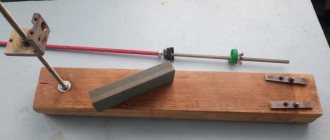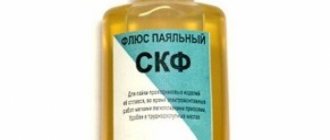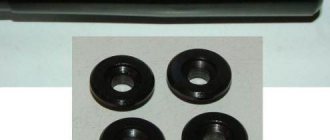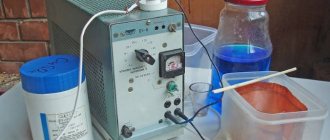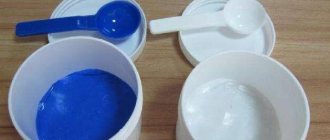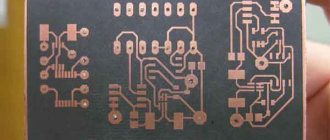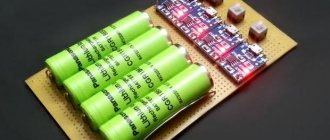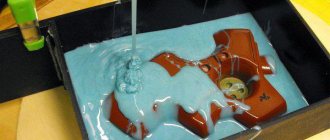Hydrochloric acid is used in the manufacture of some explosives. Now it is a recursor, and you won’t be able to purchase it in Himmag. But it is quite easy to make at home. Chemically pure concentrated hydrochloric acid is a colorless liquid that fumes in air (hydrogen chloride is released) with a pungent odor. The density of hydrochloric acid is 1.19, at a concentration of 37%.
Reagents:
NaCl – table salt. In principle, any chloride will do, KCl for example.
H2SO4 – sulfuric acid. It must be concentrated (chars the match when cold), evaporated electrolyte is quite suitable.
Protective equipment:
Hydrochloric acid is EVIL! Causes chemical burns upon contact with skin. It shouldn't get on your clothes either - it corrodes instantly. Hydrogen chloride is poisonous! It is better to produce hydrochloric acid outdoors or in a well-ventilated area. Minimum protective equipment: 1. Rubber gloves (preferably as in the photo). 2. A gas mask or respirator (will help you quickly eliminate the consequences of a possible accident without harm to health).
Equipment: 1. Electric stove or other heat source. 2. Libra. 3. Measuring cup. 4. Reaction vessel, I used a 250 ml flat bottom flask. 5. Safety bottle. Any flask will work perfectly (the main thing is that the volume of the flask is not less than the volume of the acid produced). 6. A pair of rubber plugs. 7. Tubes, you can use tubes from IVs.
The result should be a device like this.
True, there are a couple of nuances here: 1. The tubes used in the device must be of the same diameter; it is better to avoid using syringe needles as fittings. This will create a pressure difference and the device will explode (this happened to me when using a syringe needle). 2. It is better not to immerse the tube from which HCl comes into water, since water can be sucked into the system due to the high solubility of HCl. 3. The safety flask is, in principle, optional, you can do without it, but if water is sucked into the reaction flask and it may burst, spraying hot sulfuric acid.
Manufacturing:
1. Weigh out about 10-20 grams of salt. Take about the same amount of acid, 10-15 milliliters. I wrote approximately because the amount of acid depends on its concentration. I took 1:1 by volume. If the acid is 60-80%, then hydrogen chloride will first dissolve in water, and only then will it be released.
In short, LESS WATER – LESS PROBLEMS! So it is better to spend more time evaporating the electrolyte.
2. Place the salt in the reaction flask. 3. We assemble the installation, check all connections, they must be tight. 4. Pour 50-100 ml into a measuring cup. water (preferably distilled) and insert a tube into it. 5. We put on a gas mask. 6. Now the main thing is to quickly pour sulfuric acid into the reaction flask and plug the neck with a gas outlet tube. A gas mask will save you from the hydrogen chloride that will begin to be released. 7. At first the reaction occurs on its own, then the flask needs to be heated a little. NaCl + H2SO4 → Na2SO4 + 2HCl↑
The following are photographs of the device and the entire process:
In this way you can obtain acid with a maximum concentration of 37-40%. During the receiving process, you will see how the volume of water that you poured into the glass begins to increase. Continue saturating the water until the gas no longer dissolves. The acid should be stored in a tightly closed container to avoid volatilization of HCl. GOOD LUCK!
Source vzrivpaket.ru
Making acid at home
Let's try to make alkali or acid at home using improvised means.
Of course, the preparation we receive will not be concentrated (this is achieved using special equipment), but the characteristic properties of the acid will certainly be noticeable. The easiest way to obtain acid at home
will be based on the electrolysis of some solution, which dissociates to form a sulfate ion. It is also possible to obtain acid in another way, but this involves either obtaining sulfur dioxide or other chemicals that may not be available, and all of them are dangerous enough to work with at home. Therefore, we obtain, for example, sulfuric acid (diluted) from copper sulfate. The concentration obtained from vitriol is not particularly dangerous, and besides, little money is needed to obtain it. So, for the experiment we need a current source (a power supply from 15 to 30 volts is perfect). We will take a graphite anode (electrode connected to the positive) so that it does not dissolve. Cathode - it is better to take the form of a graphite plate, but you can also use copper foil.
Dilute the vitriol solution and lower the electrodes into it. At the cathode we will observe the release of a brown, loose substance - this is copper.
What is copper sulfate? This is copper dissolved in sulfuric acid. Get ready to periodically remove the cathode "-" and clean it of the copper deposited on it. The longer the experiment continues, the lighter the solution of our electrolyte becomes - copper is removed from it. If we lower our indicator into a lightened solution, the color will change to scarlet. After all, sulfuric acid! Of course, it is highly diluted, but still exhibits its properties. In order to be more sure of the resulting acid, take baking soda and drop the resulting acid onto it - in this case, a rapid release of gas should be observed - this is carbon dioxide. Sulfuric acid reacts with baking soda to form sodium salt (Na2SO4), water and carbon dioxide bubbles.
It worked! For some substances it is rather weak (because it is very diluted) and you will not observe reactions with them.
Of course, you can increase the concentration of the acid by dissolving more copper sulfate in water or by evaporating the excess water in the resulting acid. I don’t recommend doing the latter, because... acid fumes are very dangerous.
- HCl - pH=1.0
- CCl3COOH - pH=1.2
- H2C2O2 - pH=1.3
- NaHSO4 - pH=1.4
- Tartaric acid – pH=2.0
- Citric acid – pH=2.1
- Lactic acid - pH=2.4
- Salicylic acid – pH=2.4
- Succinic acid – pH=2.7
- C6H5COOH – pH=2.8
- CH3COOH - pH=2.9
- NH4H2PO4 - pH=4.0
- H2S - pH=4.1
- NaH2PO4 - pH=4.5
- KH2PO4 - pH=4.7
- HCN - pH=5.1
- NH4Cl - pH=5.1
- H3BO3 - pH=5.3
- (NH4)2SO4 – pH=5.5
- Phenol - pH=5.5
- CaCO3 - pH=7.3
- (NH4)2HPO4 - pH=7.9
- C6H5COONa – pH=8.0
- NaHCO3 - pH=8.3
- CH3COONa – pH=8.9
- Na2HPO4 - pH=9.2
- Mg(OH)2 — pH=10.0
- KCN - pH=11.1
- NH3 - pH=11.3
- Na2CO3 - pH=11.6
- Na3PO4 - pH=12.0
- Ca(OH)2 - pH=12.4
- Na2SiO3 - pH=12.6
- K2S - pH=12.8
- NaOH - pH=13.0
Which acid is more acidic?!
You have probably ever asked the question “which acid is more acidic?!” “or which of the alkalis is more caustic?!” This question can be answered by considering the pH values of solutions of acids and alkalis. There are a lot of acids, so we will consider only the most basic ones. The pH value of the solution depends on the concentration. Therefore, the table shows the pH values of aqueous solutions at a concentration of 0.1 mol/l. For poorly soluble compounds marked with an asterisk, the pH of saturated solutions is indicated. The lower the pH value of the solution, the more acidic the acid, and vice versa, the higher the pH value of the solution, the more caustic the alkali! It turns out that if you drink concentrated lemon juice, the acidity of gastric juice... will decrease!? Indeed, a solution of citric acid will only dilute the stronger hydrochloric acid contained in gastric juice.
Buying Tips
So, it is important to keep the following in mind:
- In rare cases, a large volume of this substance will be sold to a private individual - you should purchase little by little, from different suppliers.
- If it is impossible to purchase, you can try to evaporate H2SO4 from the electrolyte. The maximum density will be no more than 1.4 g/cm 3 . Evaporation is carried out in a porcelain container in a sand or plaster bath. Under no circumstances should this process be carried out indoors.
- Remember that the sale of sulfuric acid is under control because... this substance is used to produce drugs as well as homemade explosives. Even if you purchase it for innocent experiments or to refill a car battery in large quantities, this may cause unnecessary suspicion.
Amount of starting substances
To prepare an electrolyte with a given density value, you need to take a strictly defined amount of starting substances. The table below shows the most common density values for different types of electrolyte.
| Density, g/cm3 | Amount of water, l | Amount of acid, l | Amount of alkali, kg | Electrolyte freezing temperature, °C |
| 1,24 | 0,819 | 0,242 | -45 | |
| 1.25 | 0,809 | 0,253 | -50 | |
| 1.26 | 0,8 | 0,263 | -55 | |
| 1.27 | 0,791 | 0,274 | -60 | |
| 1.28 | 0,781 | 0,285 | -65 | |
| 1,15 – 1.21 | 3 | 1 | -19 … +35 | |
| 1.25 – 1.27 | 2 | 1 | -20 … -40 |
To increase the permissible operating temperature in regions with hot climates or in enterprises with high ambient temperatures, caustic lithium is added to alkaline batteries in an amount of 15-20 g. per liter of electrolyte.
Electrolyte density
To fill batteries, compositions with precisely defined concentrations of constituent substances are used. To facilitate control of the quantitative composition, the concept of density was introduced. This is explained by the fact that distilled water has a density of 1 g/cm3 and any extraneous additives increase this value. Sulfuric acid and alkali have much higher specific gravity values, therefore, by measuring the density of the solution, the composition of the electrolyte can be easily determined. Density is measured using a simple device, and how to measure density, read this article .
What is formed during the interaction
The acidic residue is no longer as dangerous as the original component. It is interesting that it is the reaction with the release of carbon dioxide that soda is responsible for adding it to bread - the carbon dioxide released due to interaction with lactic acid raises the dough and makes bubbles in it.
The neutralization reaction occurs in approximately the same way: the base reacts with H2SO4 and carbon dioxide is released. Therefore, to prevent this chemical experiment from turning into a disastrous life experience, it should be carried out in a ventilated area.
On the question of how much soda is needed to neutralize H2SO4. If you take 1 part acid, 1 part alkali will be useful to react with it, that is, the ratio will be 1:1. But concentrated acid requires more soda, here the ratio will increase to 1:2. Soda solution required 3%.
In addition, if it is necessary to provide assistance for an acid burn, then prepare a solution of soda in a very approximate amount: 1 teaspoon of alkali and 2.5 glasses of water. How effective is the reaction? Feedback from those who often encounter it will help you figure this out.
Recommended for you:
How to apply and use soda ash at home
Water acidity
Most living organisms can only exist in environments close to neutral. This is due to the fact that under the influence of H+ and OH- ions, many proteins containing acidic or basic groups change their configuration and charge. And in strongly acidic and strongly alkaline environments, the peptide bond breaks, which connects individual amino acid residues into long protein chains. Because of this, ultrabasic (highly alkaline) solutions cause alkaline burns to the skin and destroy silk and wool, which are made up of protein. All living organisms are forced to maintain a certain acidity value in intracellular fluids (and since the cell consists of 80% water, then the acidity of the water
). Natural water is capable of maintaining a pH value more or less constant, even if a certain amount of acid or base enters it from the outside. If a drop of concentrated hydrochloric acid is added to a liter of distilled water, the pH will drop from 7 to 4. And if a drop of hydrochloric acid is added to a liter of river water with pH = 7, the pH will hardly change. Acids and bases entering natural water are neutralized by carbon dioxide and bicarbonate ions dissolved in it: H++HCO-3 → H2O+CO2; OH-+CO2→HCO-3.
Disposing of acid at home
Some acid solutions are also used in everyday life. For example, “solyanka” is used to get rid of limescale. It is also used to remove rust stains from clothing.
Popular articles Hairpin with a flower
Acetic acid is part of the well-known vinegar and vinegar essence.
How to dispose of expired acetic acid? To dispose of it at home, you must:
Take a plastic container with a volume twice the volume of the solution to be disposed of. To prevent the container from melting or catching fire, transfer the empty container to a bucket of ice. Pour water into an empty container Carefully pour the acid solution into the water, paying attention to the temperature of the container
Important! You cannot pour water into concentrated acid, otherwise the water may instantly boil and the acid may splash.
Using indicator paper (purchased at a specialty store), determine the pH of the solution to be disposed of. The lower the pH, the greater the amount of solution required for the neutralization reaction will be needed.
Make the solution necessary for neutralization. The substances most commonly used for this purpose (for example, magnesium hydroxide) can be purchased in stores. Carry out a neutralization reaction
The solutions prepared at the previous stage react with disposed acids, ultimately forming salts and water. The process can be considered complete if the indicator paper corresponds to a pH level of 6 - 7. Pour the resulting safe mixture down the drain (it is advisable to keep the water tap open).
Nuances of sulfuric acid processing
How to dispose of sulfuric acid? After all, as a rule, in addition to itself, this kind of waste contains many impurities (for example, wastewater). Let's consider three ways to dispose of sulfuric acid waste:
- Carrying out a neutralization reaction without subsequent use of the resulting product. For this purpose, alkalis and strong bases are used.
- Use of sulfuric acid waste. This method is not widely used due to the presence of large amounts of impurities in such waste.
- Regeneration of the sulfuric acid mixture in order to obtain a pure sulfuric acid product. For this, methods such as adsorption, coagulation, evaporation, etc. are used.
During the processing process, containers for storing sulfuric acid are used, usually made of polymers (polyethylene, polypropylene, etc.)
Reactor manufacturing attempt No. 2
I solved the problem with the reactor melting by replacing plastic with wood. I cut out a round piece from a piece of OSB and drilled 3 holes in it, two for electrodes and one for gas exhaust. I also added 2 more bolts to the design to make it easier to connect and disconnect both terminals and electrodes; the advantage was that they increased the tightness of the structure. Also, for convenience, I replaced the pipe with a shorter one and applied silicone sealant to the bottom of the wooden plug. I used the sealant as a gasket for tightness.
Bolts for easy connection
Bolts for easy connection
Bolts for easy connection
Now it seems like it shouldn’t melt, as I thought in the trailer, the idea justified itself during the test; nothing melted, however, I missed another point; after all, the lid did not fit evenly to the jar and, therefore, gas came out of the cracks since there was not sufficient tightness. I quickly tried to solve the problem with ordinary zip ties; this helped in part, but this is not a solution to the problem.
Using zip ties
The time has come to design a new reactor; let’s not give up and continue our research experiments.
ความคิดเห็น • 0
the acid is not diluted but the solution is saturated because there is sulfur in it, which has not gone anywhere and the electrolyte remains since silver reacted with sulfur. I'm
wildly sorry, but do not mislead people, hodgepodge with copper does not react thclips.com/video/cA25vyFcL6A/วีดีโอ .html, and copper apparently dissolves, due to the fact that the sulfuric acid from the electrolyte does not completely react with the salt and something remains
Copper does not dissolve in sulfuric acid and a mixture of hydrochloric and sulfuric acid also does not dissolve copper.
It is not possible to filter metals in a liquid; you can precipitate them and then filter them
“there was a reaction in the process” um where is the reaction in the video? somehow she wasn’t anywhere.
the reaction lasts several days and proceeds slowly.
“behind the scenes” and why behind the scenes? Why not show me how you do it? You seem to be twisting something.
What electrolyte concentration?
Electrolyte density is 1.27.
Question. Will the concentration increase if you evaporate?
@Detalius Thanks. Understood.
No, there is no need to evaporate, the chlorine evaporates.
Have you tried evaporating the electrolyte x3 times for a more concentrated H2SO4?
If there is no water, then the hodgepodge will have nothing to dissolve in; it simply won’t work.
For aqua regia suitable for dissolving gold
You have been issued a transcript of “Khimik”
Please tell me. Can I use electrolyte from an old battery?
Do you have to wait a week? Isn’t it possible to just shake it so that the salt dissolves and use it right away?
Hello, will it dissolve lead?
What percentage did it turn out to be? 30%, 40%, 50%. Thank you in advance.
Can I ask a professional? I made acid using this method, but the electrolyte evaporated a little (it turned out to be about 55%). I defended it for almost a week. Yesterday I decided to filter. It didn’t work through a cotton pad, because it liquefied and fell into the watering can. Strained through a cloth. I put it in the barn and went to work at night. In the morning it came - and at the bottom there was a sediment in the form of transparent crystals like a herringbone or a hedgehog, in short, thorns. What it is? There was frost at night. I would have assumed that these were salts of sulfuric acid, if not for the fact that I had previously frozen hodgepodge (albeit from salt and a regular electrolyte of 1.27) in the freezer, and the sediment was completely different.
I didn't do that, I can't say. Try leaving it at room temperature. The crystals should melt, most likely it is the salt that has come out.
Chemical Spectrum Properties
Acid interacts with many metals and salts. It is considered quite strong and is on par with chamois. The main reaction manifests itself to all groups of metals located to the left of hydrogen (magnesium, iron, zinc - electrical potentials).
A diluted hydrochloric solution reacts with salts, but only with those formed by less strong acids. The well-known sodium and calcium carbonate, after interacting with it, disintegrate into water and carbon monoxide.
Nitric acid
– qualitative reaction to saline solution. To obtain it, you need to add silver nitrate to this reagent, as a result, a white precipitate will form, from which a nitrogen substance is obtained
Many interesting experiments are carried out using this mixture of water and hydrogen. For example, they dilute it with ammonia. As a result, you will get white smoke, thick, with the consistency of small crystals. Methylamine, aniline, manganese dioxide, potassium carbonate are reagents that are also susceptible to the influence of acid.
Destruction of other acids
Milk, phosphorus and other types of toxic substances are destroyed by burning in specially equipped ovens.
Disposal of nitric acid is also carried out by combustion. This method gives positive results from an environmental and economic point of view.
Proper elimination of toxins is an important process. Following the standards allows you to preserve the environment and eliminate negative impacts on humans. Disposal of waste acids is carried out only at landfills, subject to all requirements for containers and the recycling process.
Other uses of acid in everyday life
An acid composition can easily clean faience plumbing from limescale and rust, remove urinary stone and other contaminants. For greater effect, an inhibitor (for example, methenamine) is added to the product, which slows down the chemical reaction.
The procedure is carried out as follows: the acid is diluted with water until a 5% concentration is reached and an inhibitor is added at the rate of 0.5 g per 1 liter of liquid. The resulting composition is treated with the surface and left for 30-40 minutes (depending on the degree of contamination), after which it is washed with water.
Popular articles How to make a fluffy Christmas tree out of paper. Christmas tree made of paper. the best ideas and master classes with step-by-step photos
A weak acid solution is also used to remove berry stains, ink or rust from fabrics. To do this, the material is soaked in the composition for some time, after which it is thoroughly rinsed and washed as usual.
Descaling a kettle
For this purpose, use a 3-5% solution of hydrochloric acid, which is poured into a kettle and heated to 60-80°
C for 1-2 hours or until scale deposits disintegrate. After this, the scale becomes loose and can be easily removed with a wooden spatula.
The effectiveness of the method is due to the fact that the reagent reacts with magnesium and calcium carbonates and converts them into soluble salts. The carbon dioxide released during this process destroys the scale layer and makes it loose. After removing salt deposits, wash the dishes thoroughly with clean water.
Important point!
This method is not suitable for descaling enamel or aluminum kettles with chips and cracks: this will lead to corrosion of the metal and severe damage to it.
How do you get it?
The process of producing salt liquid consists of the stages of obtaining hydrogen chloride and absorbing it with water.
There are three industrial methods for producing hydrogen chloride:
from by-product gases (exhaust gases) of a number of technological processes. The last method is the most common. By-product HCl is typically generated during the dehychlorination and chlorination of organic compounds, the manufacture of potash fertilizers, and the pyrolysis of metal chlorides or organic wastes containing chlorine.
Making hydrochloric acid at home
Hydrochloric acid is used in the manufacture of some explosives. Now it is a recursor, and you won’t be able to purchase it in Himmag. But it is quite easy to make at home. Chemically pure concentrated hydrochloric acid is a colorless liquid that fumes in air (hydrogen chloride is released) with a pungent odor. The density of hydrochloric acid is 1.19, at a concentration of 37%.
Reagents:
NaCl – table salt. In principle, any chloride will do, KCl for example.
H2SO4 – sulfuric acid. It must be concentrated (chars the match when cold), evaporated electrolyte is quite suitable.
Protective equipment:
Hydrochloric acid is EVIL! Causes chemical burns upon contact with skin. It shouldn't get on your clothes either - it corrodes instantly. Hydrogen chloride is poisonous! It is better to produce hydrochloric acid outdoors or in a well-ventilated area. Minimum protective equipment: 1. Rubber gloves (preferably as in the photo). 2. A gas mask or respirator (will help you quickly eliminate the consequences of a possible accident without harm to health).
Equipment: 1. Electric stove or other heat source. 2. Libra. 3. Measuring cup. 4. Reaction vessel, I used a 250 ml flat bottom flask. 5. Safety bottle. Any flask will work perfectly (the main thing is that the volume of the flask is not less than the volume of the acid produced). 6. A pair of rubber stoppers. 7. Tubes, you can use tubes from IVs.
The result should be a device like this.
True, there are a couple of nuances here: 1. The tubes used in the device must be of the same diameter; it is better to avoid using syringe needles as fittings. This will create a pressure difference and the device will explode (this happened to me when using a syringe needle). 2. It is better not to immerse the tube from which HCl comes into water, since water can be sucked into the system due to the high solubility of HCl. 3. The safety flask is, in principle, optional, you can do without it, but if water is sucked into the reaction flask and it may burst, spraying hot sulfuric acid.
Manufacturing:
1. Weigh out about 10-20 grams of salt. Take about the same amount of acid, 10-15 milliliters. I wrote approximately because the amount of acid depends on its concentration. I took 1:1 by volume. If the acid is 60-80%, then hydrogen chloride will first dissolve in water, and only then will it be released.
In short, LESS WATER – LESS PROBLEMS! So it is better to spend more time evaporating the electrolyte.
The following are photographs of the device and the entire process:
In this way you can obtain acid with a maximum concentration of 37-40%. During the receiving process, you will see how the volume of water that you poured into the glass begins to increase. Continue saturating the water until the gas no longer dissolves. The acid should be stored in a tightly closed container to avoid volatilization of HCl. GOOD LUCK!
Acid solutions
Approximate solutions. In most cases, the laboratory has to use hydrochloric, sulfuric and nitric acids. Acids are commercially available in the form of concentrated solutions, the percentage of which is determined by their density.
Acids used in the laboratory are technical and pure. Technical acids contain impurities, and therefore are not used in analytical work.
Concentrated hydrochloric acid smokes in air, so you need to work with it in a fume hood. The most concentrated hydrochloric acid has a density of 1.2 g/cm3 and contains 39.11% hydrogen chloride.
The dilution of the acid is carried out according to the calculation described above.
Example. You need to prepare 1 liter of a 5% solution of hydrochloric acid, using a solution with a density of 1.19 g/cm3. From the reference book we find out that a 5% solution has a density of 1.024 g/cm3; therefore, 1 liter of it will weigh 1.024 * 1000 = 1024 g. This amount should contain pure hydrogen chloride:
An acid with a density of 1.19 g/cm3 contains 37.23% HCl (we also find it from the reference book). To find out how much of this acid should be taken, make up the proportion:
or 137.5/1.19 = 115.5 acid with a density of 1.19 g/cm3. Having measured out 116 ml of acid solution, bring its volume to 1 liter.
Sulfuric acid is also diluted. When diluting it, remember that you need to add acid to the water
, and not vice versa. When diluted, strong heating occurs, and if you add water to the acid, it may splash, which is dangerous, since sulfuric acid causes severe burns. If acid gets on clothes or shoes, you should quickly wash the doused area with plenty of water, and then neutralize the acid with sodium carbonate or ammonia solution. In case of contact with the skin of your hands or face, immediately wash the area with plenty of water.
Particular care is required when handling oleum, which is a sulfuric acid monohydrate saturated with sulfuric anhydride SO3. According to the content of the latter, oleum comes in several concentrations.
It should be remembered that with slight cooling, oleum crystallizes and is in a liquid state only at room temperature. In air, it smokes, releasing SO3, which forms sulfuric acid vapor when interacting with air moisture.
It is very difficult to transfer oleum from large to small containers. This operation should be carried out either under draft or in air, but where the resulting sulfuric acid and SO3 cannot have any harmful effect on people and surrounding objects.
If the oleum has hardened, it should first be heated by placing the container with it in a warm room. When the oleum melts and turns into an oily liquid, it must be taken out into the air and then poured into a smaller container, using the method of squeezing with air (dry) or an inert gas (nitrogen).
When nitric acid is mixed with water, heating also occurs (though not as strong as in the case of sulfuric acid), and therefore precautions must be taken when working with it.
Solid organic acids are used in laboratory practice. Handling them is much simpler and more convenient than liquid ones. In this case, care should only be taken to ensure that the acids are not contaminated with anything foreign. If necessary, solid organic acids are purified by recrystallization (see Chapter 15 “Crystallization”),
Precise solutions. Exact solutions of acids are prepared in the same way as approximate ones, with the only difference that at first they strive to obtain a solution of a slightly higher concentration, so that later it can be diluted precisely, according to calculations. For precise solutions, use only chemically pure preparations.
The required amount of concentrated acids is usually taken by volume calculated based on density.
Example. You need to prepare 0.1 and. H2SO4 solution. This means that 1 liter of solution should contain:
An acid with a density of 1.84 gsmg contains 95.6% H2SO4 n to prepare 1 liter of 0.1 n. of the solution you need to take the following amount (x) of it (in g):
The corresponding volume of acid will be:
Having measured exactly 2.8 ml of acid from the burette, dilute it to 1 liter in a volumetric flask and then titrate with an alkali solution to establish the normality of the resulting solution. If the solution turns out to be more concentrated), the calculated amount of water is added to it from a burette. For example, during titration it was found that 1 ml of 6.1 N. H2SO4 solution contains not 0.0049 g of H2SO4, but 0.0051 g. To calculate the amount of water needed to prepare exactly 0.1 N. solution, make up the proportion:
Features of electrolyte preparation technology
When preparing yourself, remember the following:
- the density of acid and alkali is much higher than the density of water;
- reactions of mixing acid with water and dissolving alkali occur with the release of high temperatures (up to 80-90°C);
- acids and alkalis react with most metals.
From the above it follows that the dishes for preparing electrolyte must be made of material that is resistant to aggressive substances and temperature. Glassware and ceramics best meet these requirements. The use of plastic utensils is possible provided that they are not heated to high temperatures. You cannot use enamel cookware, since if there are invisible cracks in the enamel, the electrolyte will be contaminated with metal salts. The same applies to stainless steel products. Such materials do not react with water, but manufacturers do not guarantee its neutrality with respect to aggressive substances.
Preparation of acid electrolyte
The high density of the acid and the ability to heat up when mixed with water determined the specifics of preparing the solution: the acid must be poured into water. If you do the opposite, then the water on top will heat up to the boiling point and splash out along with drops of acid.
To reduce heating, it is advisable to dilute the acid in two stages. At the first stage, a solution with a density of 1.40 is prepared, and then, after cooling, the electrolyte of the required concentration is made. A solution with a density of 1.40 is called a correction solution. It is used to correct the electrolyte density in working batteries. After adding the acid to the water, the mixture is gently stirred with a glass rod. The prepared electrolyte must be left for some time (from half to a day) for its uniform mixing and complete cooling.
Preparation of alkaline electrolyte
The required amount of alkali is poured into a measured amount of water and stirred until completely dissolved. It is also necessary to wait until the sediment dissolves completely and the temperature drops to normal.
The alkali solution must be stored in a hermetically sealed container, preventing air from entering. Carbon dioxide easily reacts with alkalis to form carbonates - salts of carbonic acid. As a result, the content of the active substance in the solution decreases over time.
Solutions of acid and alkali should be transparent or have a slight yellowish tint. The presence of turbidity in the settled solution indicates low purity of the original components and are unsuitable for use in batteries.
Component Requirements
The normal course of chemical reactions places special demands on the electrolyte substances. The main requirement is a high degree of purity of materials. The purer the chemicals used to prepare the electrolyte, the higher the efficiency of the batteries and their longevity.
According to the requirements of the standards, battery sulfuric acid must contain at least 92 - 94% sulfuric acid. The remaining 6–8% is water. The content of metal salts is no more than thousandths of a percent.
Attention! The alkali is produced in dry form and has similar requirements.
If problems usually do not arise with the listed substances (responsibility for cleanliness rests with enterprises that produce materials and trade organizations), then with water things are somewhat worse. Many car enthusiasts do not distinguish between ordinary and distilled water.
Tap water is saturated with solutions of various metal salts and organic substances. Simple boiling can get rid of a small amount of hardness salts, while the remaining substances remain unchanged. In tap water, the most dangerous for batteries are iron salts, which are found there in high concentrations.
The active substances for the electrolyte must be diluted with distilled water, which differs in that its salt content is minimal. In terms of its chemical and physical parameters, such water practically corresponds to ideal water.
Use in the food industry
The food industry uses E507 in the processing of various products. Its main use in the food industry is in the production of corn syrups, especially high fructose corn syrups. It is also often found in mayonnaise and is part of citric acid, gelatin, and fructose.
Hydrochloric acid can also be used for acid modification of corn starch and for adjusting the pH of intermediates and final products.
The most common use is in the production of soft drinks, which accounts for 70-75% of demand.
E507 is also used in other areas of the food industry, including the production of hydrolyzed vegetable protein and soy sauce. It is used to acidify crushed bones, to produce gelatin, and as an acidifying agent for foods such as sauces, vegetable juices, and canned foods.
Popular articles Congratulations on May 9, Victory Day
Hydrochloric acid is often used in the production of:
- artificial sweeteners;
- lysine and choline chloride (both used primarily as animal feed additives);
- citric acid;
- corn starch;
- soft drinks;
- soy sauce.
Burns and poisoning
No matter how effective this remedy is, it is dangerous. Hydrochloric acid, depending on the concentration, can cause four degrees of chemical burns:
- There is only redness and pain.
- Blisters with clear liquid and swelling appear.
- Necrosis of the upper layers of skin is formed. The blisters fill with blood or cloudy contents.
- The lesion reaches the tendons and muscles.
If the substance somehow gets into your eyes, you need to rinse them with water and then with a soda solution. But in any case, the first thing you need to do is call an ambulance.
If acid gets inside, it can cause acute pain in the chest and abdomen, swelling of the larynx, and bloody vomit. As a result - severe pathologies of the liver and kidneys.
And the first signs of vapor poisoning include a dry, frequent cough, choking, damage to teeth, burning in the mucous membranes and abdominal pain. The first emergency aid is washing and rinsing the mouth with water, as well as access to fresh air. Only a toxicologist can provide real help.
How to properly dispose of acids
Important! Acids are known to be poisonous. If they are handled carelessly, if they get on the skin or inside the body, burns, severe poisoning and even death can occur.
The process regarding the disposal of such aggressive media in enterprises begins with the container in which these substances are transported and stored. Requirements for containers for disposal:
- The conditions for the tightness of the container must be strictly observed (it must be completely sealed), and special markings must be applied to it.
- The container must be made of a material that is inert to the substances carried in it to avoid damage to the container itself.
- Mixing different acids is prohibited.
- Transportation of containers with aggressive waste must be carried out using special transport.
Acid waste received for processing is neutralized (detoxified) using reagents, which makes it possible to reduce the concentration of waste compounds to an acceptable level. If the waste contains solid impurities, they should be separated. The separation is carried out using a reaction apparatus, which has a stirrer and a chamber filter press. The sludge produced by the separation process is usually disposed of in hazardous waste sites or landfilled. The remaining liquid, depending on the composition of the spent acid, is sent for further processing or destroyed.
Spent hydrocyanic acid, hydrofluoric acid, picric acid are also disposed of in accordance with the characteristics of the ongoing process (for each substance) in accordance with all safety regulations. Disposal of nitric acid proceeds according to the general technology described above, taking into account some nuances.
The features of disposal of other common acid wastes are described below.
Causes of blockages
The sewer system moves wastewater with a high content of organic matter and fats. They stick to the walls in a thin layer, which gradually grows and turns into a full-fledged blockage. As a rule, it is located near the drain hole of kitchen sinks or other plumbing fixtures. Most often, the siphon suffers from fat deposits, the bend of which actively collects sticky and viscous components of wastewater.
In addition, a common cause is foreign objects falling into the sewer. There may be hair, paper, construction waste (sand, residues of adhesive solutions), feminine pads and other unwanted components. They get stuck in bends or narrowing areas of the pipes, causing permanent blockages. No methods other than mechanical cleaning give results.
On cast iron pipes, there are cases of scale detachment from the inner surface of the walls. It remains inside and quickly becomes overgrown with fat, trapping small particles of organic matter. Mechanical cleaning of pipes will also be a solution to the problem.
COMMENTARE • 0
the acid is not diluted but the solution is saturated because there is sulfur in it, which has not gone anywhere and the electrolyte remains because silver reacted with sulfur
I'm wildly sorry, but don't mislead people, hodgepodge with copper does not react declips.net/video/cA25vyFcL6A/video.html, and copper apparently dissolves, due to the fact that sulfuric acid from the electrolyte does not completely react with salt and something yes remains
Copper does not dissolve in sulfuric acid and a mixture of hydrochloric and sulfuric acid also does not dissolve copper.
It is not possible to filter metals in a liquid; you can precipitate them and then filter them
“there was a reaction in the process” um where is the reaction in the video? somehow she wasn’t anywhere.
the reaction lasts several days and proceeds slowly.
“behind the scenes” and why behind the scenes? Why not show me how you do it? You seem to be twisting something.
What electrolyte concentration?
Electrolyte density is 1.27.
Question. Will the concentration increase if you evaporate?
@Detalius Thanks. Understood.
No, there is no need to evaporate, the chlorine evaporates.
Have you tried evaporating the electrolyte x3 times for a more concentrated H2SO4?
If there is no water, then the hodgepodge will have nothing to dissolve in; it simply won’t work.
For aqua regia suitable for dissolving gold
You have been issued a transcript of “Khimik”
Please tell me. Can I use electrolyte from an old battery?
Do you have to wait a week? Isn’t it possible to just shake it so that the salt dissolves and use it right away?
Hello, will it dissolve lead?
What percentage did it turn out to be? 30%, 40%, 50%. Thank you in advance.
Can I ask a professional? I made acid using this method, but the electrolyte evaporated a little (it turned out to be about 55%). I defended it for almost a week. Yesterday I decided to filter. It didn’t work through a cotton pad, because it liquefied and fell into the watering can. Strained through a cloth. I put it in the barn and went to work at night. In the morning it came - and at the bottom there was a sediment in the form of transparent crystals like a herringbone or a hedgehog, in short, thorns. What it is? There was frost at night. I would have assumed that these were salts of sulfuric acid, if not for the fact that I had previously frozen hodgepodge (albeit from salt and a regular electrolyte of 1.27) in the freezer, and the sediment was completely different.
Why is acid flux needed?
Metals include highly active substances. Many of them oxidize easily and quickly in the presence of air. The resulting oxides are converted into hydroxides under the influence of atmospheric moisture.
A mixture of oxidation products is clearly visible on iron products after storage in air. It's called rust. Other metals are also coated with an oxide layer, which prevents anything from being soldered to the product.
Acid fluxes help to cope with the problem, the simplest of which is soldering acid. Under this name, several different single-component or complex compositions are collected, many of which can be prepared with your own hands.
Storage and transportation
Industrial hydrochloric acid is stored and transported in specialized polymer-coated tanks and containers, polyethylene barrels, glass bottles packed in boxes. Hatches of containers and tanks, caps of barrels and bottles must ensure the tightness of the container. The acid solution should not come into contact with metals located in the voltage line to the left of hydrogen, as this can cause explosive mixtures.
Security measures
Preparation of electrolyte is dangerous due to the use of very aggressive substances. Concentrated solutions of acids and alkalis can cause difficult-to-heal acid burns, and if they come into contact with the eyes, they can cause blindness.
Before work, you should prepare a neutralizing solution to wash off any drops of electrolyte that accidentally fall on the body:
- 1% baking soda solution when working with acid.
- Table vinegar to neutralize alkali. The vinegar should be diluted by half with water.
You should work with rubber gloves and be sure to wear safety glasses or a mask. If electrolyte gets on your skin, you should thoroughly rinse the area of contact with a neutralizing solution, and after washing your eyes, immediately consult a doctor.
All work is carried out outdoors or in a well-ventilated area. Acid vapors released during the preparation of the solution (especially when hot) cause irritation of the upper respiratory tract, expressed by severe coughing and swelling of the mucous membranes.
As clothes at home, you can use those that you don’t really mind, since even after washing with a neutralizing solution, some of the aggressive substance will remain between the fibers of the fabric and things will be hopelessly damaged.
Will need
To conduct the experiment we will need:
- Acid electrolyte for batteries (sold in a car store);
- Distilled water (ibid);
- Table salt (available in any kitchen);
- Baking soda (see safety precautions).
From the dishes you need:
- Glass flask;
- A vessel with sand where you can place the flask;
- Several disposable cups 200 ml;
If you have a heat-resistant flask, you can heat it under the open flame of a burner. But I still recommend using sand, in which case it will absorb acid. You will also need a pair of plumbing angles with a diameter of 50 mm and a burner (in my case, alcohol, but I recommend using a gas one).
Other types of batteries: is it possible to prepare electrolyte for them yourself?
Separately, I would like to draw attention to modern lead-acid power supplies - gel and AGM. They can also be filled with a personally prepared solution, which is in a specific form - in the form of a gel or inside separators
To refill gel batteries you will need another chemical component - silica gel, which will thicken the acid solution.
Nickel-cadmium and iron-nickel batteries
Unlike lead power sources, cadmium- and iron-nickel ones are filled with an alkaline solution, which is a mixture of distilled water and caustic potassium or sodium. Lithium hydroxide, which is part of this solution for certain temperature conditions, allows you to increase the service life of the battery.
Table 2. Composition and density of electrolyte for cadmium- and iron-nickel batteries.
It is recommended to operate nickel-iron power supplies under the same conditions as cadmium-nickel ones. However, it is worth noting that they are more susceptible to low temperatures. Therefore, they should be used up to minus 20 degrees.
Electrolyte composition
An electrolyte is a solution of the active substance in distilled water. Depending on the type of battery used, the active substance is:
- sulfuric acid for lead-acid batteries;
- alkalis (caustic sodium or potassium) for alkaline batteries.
In alkaline batteries, to meet special requirements, the electrolyte may contain the addition of caustic lithium. Also, caustic lithium is the main one in lithium-ion and lithium-polymer batteries.
Differences in electrolytes for different types of batteries
Despite the fact that the principle of operation of the solution is the same for different power sources, you should be aware of some differences in the composition. Depending on the composition, it is customary to distinguish alkaline and acidic electrolytes.
Alkaline batteries
This type of power source is characterized by the presence of nickel hydroxide, barium oxide and graphite. The electrolyte in this type of battery is a 20% solution of caustic potassium. Traditionally, the additive of lithium monohydrate is used, which allows to extend the life of the battery.
Alkaline power sources are characterized by the absence of interaction of the potassium solution with substances formed during battery operation, which helps to minimize consumption.
Acid batteries
This type of power supply is one of the most traditional, which is why the solution in them is familiar to many - a mixture of distilled water and sulfur solution. Electrolyte concentrate for lead-acid batteries is inexpensive and characterized by the ability to conduct large currents. The density of the liquid must correspond to climatic conditions.
Table 1. Recommended electrolyte density
Method for diluting electrolyte for an alkaline power source
The density and amount of electrolyte in such batteries is indicated in the operating instructions for the power source or on the manufacturer’s website.
Required solution density
The amount of solid alkali is equal to the amount of electrolyte divided by
Electrolyte is the most important component of rechargeable batteries. Without it, their work is impossible, and both the technical parameters and the durability of the batteries depend on the quality and correct preparation.
Nowadays it is possible to purchase electrolyte for all types of batteries, but sometimes there is a need to make it yourself. It is not difficult to prepare electrolyte for a battery if a number of conditions are met.
Why is analysis prescribed and how are the results deciphered?
It should be noted that a biochemical blood test to check uric acid levels is not considered standard. Doctors usually prescribe it if they suspect diseases that cause slow metabolism or kidney dysfunction.
Blood sampling is carried out in the morning on an empty stomach, usually no more than 10 ml is taken from the patient. The amount of metabolite gives the physician the opportunity to assess the condition of the organs and how correctly the body systems function.
If the content of this substance in the plasma is increased, the patient will be prescribed appropriate treatment that will prevent the accumulation of excess salts and regulate the exchange of nucleic acids.
In some laboratories, a form with the results is given directly to the patient. To decipher the result yourself, you need to know that the content of the compound is calculated in kilomoles per liter. This indicator indicates the number of molecules contained in 1 liter of blood.
Where to buy sulfuric acid
In principle, sulfuric acid is not sold in pharmacies. A private individual can purchase its non-concentrated solution (30-35%) in stores that sell auto parts and auto chemicals. More concentrated solutions are precursors that are not legally sold to individuals.
Before you find out where to buy sulfuric acid, here are some tips from people who have made such a purchase.

